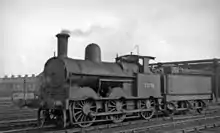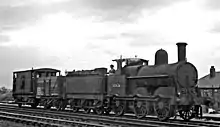LNWR 18in Goods Class
The LNWR 18-inch Goods was a class of 310 0-6-0 freight steam locomotives built by the London and North Western Railway at their Crewe Works between 1880 and 1902.[1]
| LNWR 18-inch Goods (“Cauliflower”) | |||||||||||||||||||||||||||||
|---|---|---|---|---|---|---|---|---|---|---|---|---|---|---|---|---|---|---|---|---|---|---|---|---|---|---|---|---|---|
 A photo of 1382 in photographic grey livery, as built. | |||||||||||||||||||||||||||||
| |||||||||||||||||||||||||||||
| |||||||||||||||||||||||||||||
| |||||||||||||||||||||||||||||
| |||||||||||||||||||||||||||||


They were also known officially as the Express Goods 5ft 0in, and unofficially as the Crested Goods or Cauliflower Class, due to the application of the large LNWR crest on the middle splasher in the original livery.[2]
Design
The design featured a boiler pressed to 150 lbf/in2 (1.03 MPa) delivering saturated steam to two 18 by 20 in (457 by 508 mm) cylinders connected by Joy valve gear to the driving wheels.
The dimensions quoted in the class title could be misleading: several locomotives ran for a period with 17-or-17 1⁄2-inch (432 or 444 mm) cylinders; and the “5ft 0in” referred to the diameter of the wheel centres – measured of the tyres the diameter was 5 ft 2 1⁄2 in (1,588 mm).
A tank locomotive version was also produced as the LNWR 18in Tank Class 0-6-2T.
Service
Two locomotives were withdrawn before the 1923 Grouping, leaving 308 to pass to the London, Midland and Scottish Railway, who gave them power classification 2F, and renumbered them 8315–8624. The LMS later added them to the duplicate list by the addition of 20000 to their numbers to make room for additional LMS Stanier Class 8F locomotives.
Sixty-nine locomotives entered British Railways (BR) stock in 1948. BR allocated them the numbers 58362–58430, as adding 40000 to their numbers as was done with most ex-LMS locomotives would have taken them into the 6xxxx ex-LNER series. The last one was withdrawn from British Railways service in 1955. None has been preserved.
References
- Baxter, Bertram (1979). Baxter, David (ed.). British Locomotive Catalogue 1825–1923, Volume 2B: London and North Western Railway and its constituent companies. Ashbourne, Derbyshire: Moorland Publishing Company. pp. 232–239. ISBN 0-903485-84-2.
- Casserley, H. C. & Johnston, Stuart W. (1974) [1966]. Locomotives at the Grouping 3: London, Midland and Scottish Railway. Shepperton, Surrey: Ian Allan. pp. 89–90. ISBN 0-7110-0554-0.